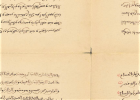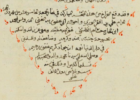
This is a collection of lessons in codicology – the study of handwritten documents or codices - and palaeography from the Muslim world. The lessons will guide you through the ways books were made and used there before the printing press, by investigating the traces left by producers, owners and readers of manuscripts. Using your mouse, you will come close to people in the manuscript age as they produced, transmitted, cherished and “consumed” the written texts.
The lessons are centered around fully digitalised manuscripts from the oriental collection of Leiden University Libraries. They include samples in Arabic, Persian and Coptic, from cultures ranging from the Maghrib to Mughal India. The lessons can be read in any order. All include suggestions for further reading and questions (with answers) or assignments.

Lesson 10 Once in a while, you will come across an old printed book in which the pages still need to...

Lesson 17 Astronomy in the Arabic world has a long history of study, and so it is not uncommon for m...

Lesson 26 The colophon is one of the first points of call when one studies a manuscript. All manuscr...